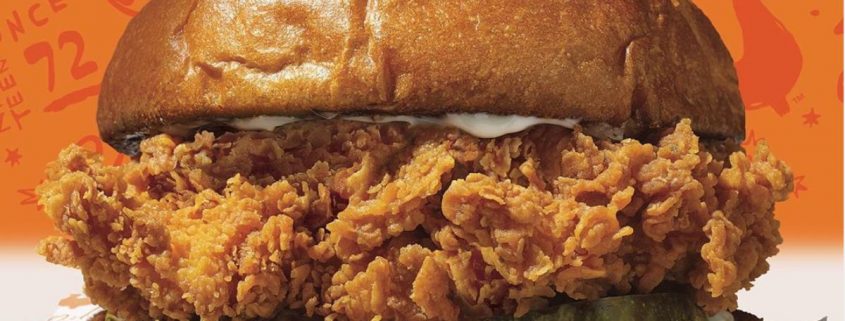Eating L.A. Before it Eats Itself: How social media made sandwich and seltzer sales skyrocket

Under the vibrant orange hue of fluorescent lights, thousands have gathered, arms outstretched toward a new temple offering a singular form of solace: chicken.
For years, it has been neglected, cast in the shadow under other chicken-serving giants. But now, it had emerged, blinking in the morning sun … a chance — at long last — in the spotlight.
Have you heard about the Popeye’s Chicken Sandwich?
A humble creation, with no bells and whistles: Popeye’s chicken, brioche bun, mayonnaise, pickles. It came unadorned, unabashed and inexpensive, a natural extension of the Popeye’s oeuvre, a simplistic-yet-satisfying product. After years of relative silence, Popeye’s burst back into the public eye with a media fireball that is only growing.
News of Popeye’s poultry product spread quickly, and instead of traditional advertising, it was a chorus of thousands of people on Twitter that propelled the Popeye’s chicken sandwich into a national sensation.
What started as a few stray tweets transformed into a full-blown chicken sandwich panic: Over the course of a few weeks from Aug. 12 to 27, heated fast food debates, hour-long drive-thru lines and countless memes spawned from the Popeye’s sandwich.
The Popeye’s chicken sandwich has gone viral.
But, another product had already gone before it.
Slinking in the shadows of early 2019, glinting from the curled hand of that girl at that one party, was an alcoholic beverage so neutral, so affable, so harmless that it was destined to be a sensation. A natural response to the rejection of sugary sodas and acceptance of lighter carbonated beverages, young America was so willing to embrace a healthier alternative to binge-drinking that White Claw eased its way to the top of every 23-year-old’s grocery list.
A drink lighter than wine, but heavier than beer, with cleaner marketing and a smoother taste: In many ways, White Claw embodies the desire to improve our unhealthy behaviors without sacrificing them. The company experienced steady growth over the course of three years until this summer, when social media again turned this product into a phenomenon.
Like the similarly marketed “healthier for you than the real thing but not really” vape Juul, White Claw cultivated itself within a community of fraternity brothers and overconfident college students, resulting in a prompt tsunami of memes, viral videos and inside jokes about the product. White Claw spread by word of mouth, and hard seltzer became the drink of the summer.
While other brands like Henry’s, Truly Hard Seltzer or even the forsaken 14% ABV Four Loko Seltzer also enjoy the online-driven success of spiked seltzer, White Claw reigns supreme.
Simply put, White Claw has gone viral.
Virality, while a source of insurmountable power and fame, is a difficult-to-handle weapon.
Like Icarus, both Popeye’s and White Claw have flown too close to the sun.
Slammed with an impossibly high demand for the chicken sandwich, Popeye’s removed it from the menu Aug. 27, sparking national outrage. Real, honest tears were shed over the temporary death of the Popeye’s sandwich. Those late to the trend were left to mourn over the thought of what could have been.
The Popeye’s chicken sandwich will return to the menu once the chain is better equipped to handle the demand, and with it, the most successful business period Popeye’s has ever had.
Similarly, White Claw has been struggling with its newfound fame, unable to physically produce enough to match the demand. The United States is entering a White Claw shortage (the fraternity brother Great Depression). The refrigerated aisle of beer across supermarket chains now contains an empty, White-Claw shaped gash in its seltzer section.
Despite their temporary setbacks, White Claw and Popeye’s are both experiencing a moment of mainstream popularity carried by social media — through memes, reviews and word of mouth, these products have inadvertently become a part of internet culture. While far from being the first examples of social media bolstering a dormant brand, the online frenzy around White Claw and Popeye’s this summer has been exceptionally effective.
It’s clear that brands and companies are aware of the power of social media: Look to Twitter accounts for brands like Wendy’s, SunnyD and Denny’s, infused with millennial and Gen-Z humor while still promoting new products. While this is a brilliant way of maintaining relevance in the public eye, the viral success of Popeye’s and White Claw isn’t the same case: It never felt intentional. Jokes came from the consumers, not from the marketers.
As the ravenous crowds surrounding Popeye’s wean off, and White Claw secures a quicker method of production, it will be interesting to see how brands interpret the series of events that transformed these products into cultural icons. Will brands try to start their own memes? Will they hire companies to plant the joke deep into Twitter culture? Is nothing sacred?
The explosive success of the Popeye’s chicken sandwich and White Claw hard seltzer indicates that virality is not just for people but also for brands — a double-edged sword, so long as companies are equipped to handle the fame.
Christina Tiber is a senior writing about food. Her column, “Eating L.A. Before It Eats Itself,” runs every other Thursday.

